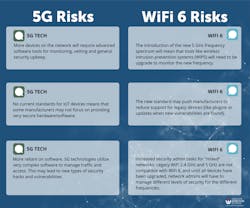How 5G and WiFi 6 Will Impact Critical Sensors
This article originally appeared in the March 2022 issue of Security Business magazine. When sharing, don’t forget to mention Security Business magazine on LinkedIn and @SecBusinessMag on Twitter.
We are living in an age where advancements in both wireless communications and remote computing are progressing at an incredible pace. For some applications, such as consumer-based products like thermometers or smart refrigerators, the development of network security policies may only need to focus on how well a specific manufacturer has implemented a device’s connectivity protocols.
For other applications, such as smart city technologies like traffic systems or devices that monitor power grids, networked security becomes a much more complicated and serious topic.
When it comes to gunshot detection sensors, we routinely advise clients on the topic of network device security because we know that these sensors – and the data they carry – are critical for law enforcement, first responders and the safety of their users. In that regard, the rise of 5G and WiFi 6 will certainly have an impact on gunshot detection technology.
Mature Communications Technologies Beginning to Overlap
In simplest terms, 5G will be the latest technological standard in very wide area, highly mobile communications applications; whereas WiFi 6, as most of us will intuit, is directed at smaller area multi-device connectivity in businesses and homes.
While technical publications have touted each technology’s higher data throughput, reduced latency and improved security, what may not be readily evident is that both technologies have begun to creep into each other’s territory. The increase in Internet of Things (IoT) devices – like weather stations on city buildings – has forced the WiFi development community to find better ways to connect many more devices in a larger public domain.
On the 5G side, factories that choose to create an in-house 5G network will benefit from assembly line robots and material supply resources being able to share large amounts of data with almost zero latency.
For the beleaguered physical security professional who will soon be bombarded with the latest vendor marketing hype, two questions jump to mind: what issues should I pay attention to when considering devices that use these technologies? And at what point should I begin considering upgrading my sensors and networking platforms?
The Good News: Data Security Is Getting Better
Both 5G and WiFi 6 were developed by IT standards groups that understood the importance of networked devices and data security. 5G, for example, was specifically developed with the following capabilities in mind: resilience, communication security, identity management, privacy, and security assurance.
On the WiFi 6 side of the fence, the Wi-Fi Alliance is now mandating WPA3 level security certifications for all Wi-Fi 6E devices – removing backwards compatibility with older WiFi-enabled devices that often lead to security breaches. WiFi 6 will also now implement encryption for all user data.
One important thing to remember is that these technologies soon may not be offered as an “either-or” solution by vendors – your phone, for example, can connect to both. The technologies are, in fact, complementary in that a large company or city may utilize devices using either 5G or WiFi 6 or both. More detailed information about the security features and benefits of both 5G and WiFi 6 can be found in a recent whitepaper published by Cisco, available at https://bit.ly/CiscoWhitepaper.
The Bad News: Increased Risk
As the old expression goes, only a bad carpenter blames his tools. While both 5G and WiFi 6 offer powerful performance and security features, poor implementation or configuration will create security gaps.
Here are some of the issues that need to be resolved for both technologies:Does the Client Really Need 5G or WiFi 6?
The previous WiFi standard (WiFi 5) stated a theoretical speed of 3.5 Gbps; WiFi 6 proposes a maximum theoretical speed of 9.6 Gbps. They both exceed standard cable speeds that hover around 1 Gbps.
If these were the only statistics being considered, one would think that every IoT manufacturer should be rushing to adopt these new technical tools; however, as we all know, there is laboratory performance and then there is real-world performance. In a recent study, analysists determined that if you are less than 6 feet from a WiFi router, the best data transmission speed is about 867 Mbps for a WiFi 5 signal (read more at www.increasebroadbandspeed.co.uk/realistic-speeds-wi-fi-5-and-wi-fi-6). This is well below a standard cable speed and yet still prone to signal interference and interception.
Should you be paying close attention to WiFi 6 and 5G? The answer depends on an institution’s goals. WiFi 6 and 5G state that many more devices can now connect at much higher speeds – but is this really needed for security purposes? If a customer is connecting hundreds of users who all have high data throughput needs – like a school full of students using virtual reality goggles or the occupants of an entire sports arena accessing an augmented reality smartphone app – the answer is yes. If, however, the end-user needs to send just 1 Mb of data every second – the equivalent of 1 minute of MP3 compressed audio or a 10-million-pixel picture from a digital camera – then the answer is a resounding no.
Applying it to Gunshot Detection Sensors
Manufacturers of critical sensors – such as gunshot detection sensors – must ensure that these devices are always available and that the data they transmit cannot be tampered with. Availability in this instance means that the sensor, be it wireless or Power over Ethernet (PoE) cable connection, must always be able to send data to a centralized software application.
The new WiFi standard is interesting and presents new analytical work for engineering teams. For a typical gunshot detection client, wewill first suggest as many wired, PoE sensors as is pertinent to the structure being monitored. Traditionally, wired is always better at providing stability, bandwidth, and latency over wireless as well as supplying a reliable power source (no batteries required). Interrupting or trying to manipulate the signal from the sensor is extremely difficult.
If it is not possible to run a cable to a sensor, then a wireless-enabled sensor must be used; however, we do not use traditional WiFi frequencies for wireless gunshot detection sensors. This is due, in part, to the often complex and confusing compatibility challenges between the wireless access point (AP) and the endpoint as there are often incompatibilities between the two.
Another reason is to avoid conflict with the corporate wireless network is to ensure that the traffic between the gunshot sensor and the back-end application does not compete with other services. This will help prioritize the delivery of sensor health and shot detection messages – and considering that sending critical messages is the point of having a gunshot detection system in the first place, this is important.
Finally, use of “standard” WiFi frequencies can be less than optimal due to building construction and other physical interferences that are common in most corporate or educational facilities.
Data Transmission Stability and Security
As vendors begin to introduce IoT sensors and devices leveraging 5G and WiFi 6, security professionals will need to work with end-user IT departments to understand how their current infrastructure will interact with these new systems.
Sometimes the best solution is one designed to operate completely apart from existing IT networking platforms. For example, the Guardian indoor wireless gunshot detection sensor utilizes LoRa (Long Range) wireless communications, which is common in the IoT space due to lower power consumption, longer range, ability to operate at a different (sub-Ghz) frequency and – most importantly – does not interfere with other WiFi installations.
Given that the sensor does not transmit large amounts of data (no voice or acoustic data, only text data averaging about 0.5 Kilobytes per second), there is no need to burden an end-user with expensive, complex components that can add unknown variables to their IT security environment.
Finally, when evaluating data transfer, WiFi technologies operating at higher frequencies – like the new WiFi 6 standard – are reportedly unable to penetrate physical barriers like concrete walls as efficiently as older technologies operating at lower frequencies.
Most physical security professionals have enough on their plate without having to become IT security experts on the side. While it is a vendor’s job to explain why a new technological advancement will help someone perform more efficiently, their first responsibility should always be to provide a solution that is proven and efficient.
Upgrading to new technologies is best done with smaller, pilot-based programs that allow both integrator and end-user to assess all aspects of the new platform – especially how issues like backwards compatibility will be addressed.
Brad Hernandez is a Senior Sales Engineer at Shooter Detection Systems, where he helps integrators and security consultants design gunshot detection solutions for their clients. Request more info about the company at www.securityinfowatch.com/12038223.




